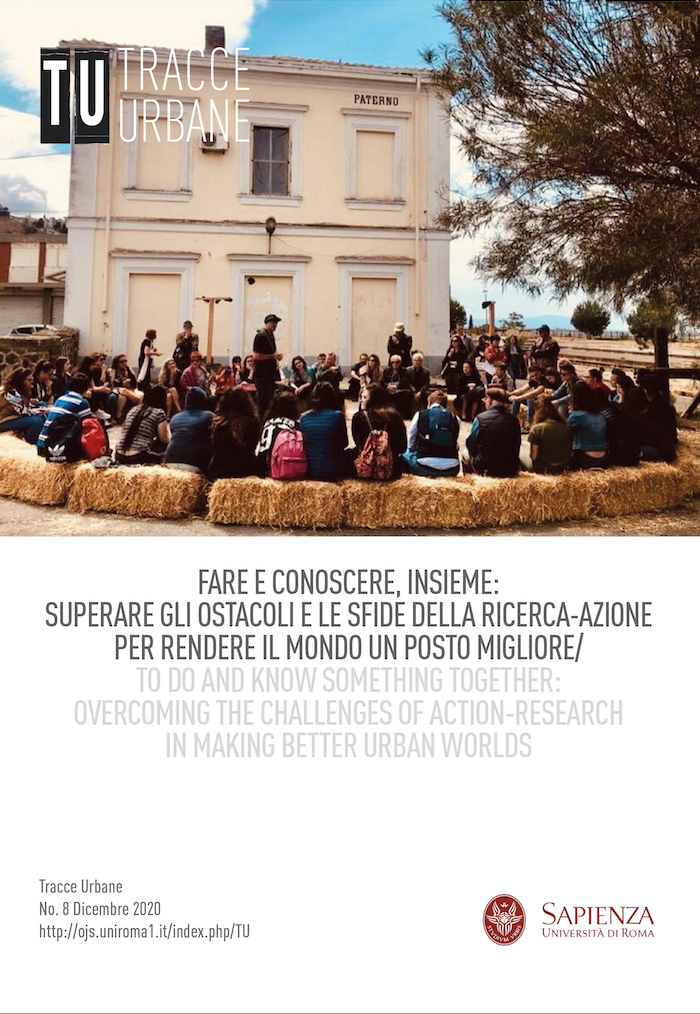Collaborative problem-solving through PhotoVoice: helping community organizations move from network building to action in Havana, Cuba
DOI:
https://doi.org/10.13133/2532-6562_4.8.17044Keywords:
PhotoVoice, Community-Based Participatory Research, Community OrganizationsAbstract
Questo articolo descrive il passaggio dalla costruzione della rete all’azione, nel quadro di ricerca partecipativa a livello comunitario. In particolare, descrivo lo sviluppo di una rete di organizzazioni comunitarie all’Avana (Cuba), e in che modo è stata utilizzata la metodologia del PhotoVoice come strumento collaborativo per scoprire e affrontare alcune sfide comuni, rimaste anche dopo la creazione della rete. Il nostro progetto PhotoVoice ha inteso 1) formare un legame più coeso tra le organizzazioni partecipanti e 2) fornire loro un ‘linguaggio condiviso’ per comunicare alcune delle loro esperienze, identificare e iniziare a risolvere alcune circostanze di fondo o trascurate. Il progetto PhotoVoice è culminato in una esposizione di 21 foto e didascalie che hanno descritto le maggiori opportunità, sfide e obiettivi di ogni organizzazione. Il processo – dai nostri primi workshop alla mostra finale – ha messo in luce alcune considerazioni chiave per le organizzazioni partecipanti e per molte altre organizzazioni della rete.
This article describes the movement from network building to action within a Community-Based Participatory Research framework. Specifically, I describe the development of a network of community organizations in Havana, Cuba, and how we utilized the PhotoVoice methodology as a collaborative tool to discover and address some common challenges that remained even after the network was established. Our PhotoVoice project sought to 1) form a more cohesive bond between the participating organizations and 2) give them a ‘shared language’ to communicate some of their experiences and identify and begin to resolve some underlying or overlooked circumstances. The PhotoVoice project culminated in a gallery of 21 photos and captions that described each organization’s greatest opportunity, challenge, and goals. The process – from our first workshops to the final exhibition – revealed some key considerations for the participating organizations as well as many other organizations in the network.
References
Cameron J. (2007). «Linking Participatory Research to Action: Institutional challenges». In: Kindon S., Pain R., Kesby M. (eds.), Participatory Action Research Approaches and Methods. New York: Routledge.
Cartwright E., Schow D. (2016). «Anthropological Perspectives on Participation in CBPR: Insights From the Water Project, Maras, Peru». Qualitative Health Research, 26: 136–140. Doi: 10.1177/1049732315617480.
Cubadebate. (2019, September 11). «Presidente Díaz-Canel informa medidas coyunturales ante situación energética de Cub». Text available on the website: http://www.cubadebate. cu/noticias/2019/09/11/presidente-diaz-canel-informa- nuevas-medidas-ante-situacion-energetica-de-cuba/#. X1wKQWhKhPZ. Date of consultation: September 12, 2019.
de la Fuente A. (2001). «Recreating racism: Race and Discrimination in Cuba’s ‘Special period’». Socialism and Democracy, 15: 65–91. Doi: 10.1080/08854300108428278.
Enria L. (2016). «Co-producing knowledge through participatory theatre: reflections on ethnography, empathy and power». Qualitative Research, 16(3): 319–329. Doi: 10.1177/1468794115615387.
Espina Prieto M. (2013). «La política social cubana para el manejo de la desigualdad». Cuban Studies, 41: 20–38. Doi: 10.1353/cub.2010.0007.
Fernandes S. (2006). Cuba Represent!: Cuban Arts, State Power, and the Making of New Revolutionary Cultures. Durham: Duke University Press.
Freire P. (1993). Pedagogy of the oppressed. London: Continuum Publishing Company.
Hergenrather K. C., Rhodes S. D., Cowan C. A., Bardhoshi G., Pula S. (2009). «Photovoice as Community-Based Participatory Research: a Qualitative Review». American Journal of Health Behavior, 33(6): 686–698. Doi: 10.5993/AJHB.33.6.6.
Kemmis S., McTaggart R., Nixon R. (2014). The Action Research Planner: Doing Critical Participatory Action Research. New York: Springer.
Mesa-lago C. (2002). «Las crecientes disparidades económicas y sociales en Cuba: Impacto y recomendaciones para el cambio». Cuba Transition Report. Miami: Institue for Cuban and Cuban- American Studies at the University of Miami.
Padilla M., Matiz-Reyes A., Colón-Burgos J. F., Varas-Díaz N., Vertovec J. (2019). «Adaptation of PhotoVoice methodology to promote policy dialog among street-based drug users in Santo Domingo, Dominican Republic». Arts and Health, 11(2): 147–162. Doi: 10.1080/17533015.2018.1444647.
Pardo I., Prato G. B., eds. (2012). Anthropology in the City: Methodology and Theory. Burlington: Ashgate.
Pauwels L. (2015). «‘Participatory’ Visual Research Revisited: A Critical-Constructive Assessment of Methodological and Social Activist Tenets». Ethnography 16: 95–117. Doi: 10.1177/1466138113505023.
WangC.C.,BurrisM.A.(1997).«Photovoice:Concept,Methodology, and Use for Participatory Needs Assessment». Health Education & Behavior, 24(3): 369–387. Doi: 10.1177/109019819702400309.
Downloads
Published
How to Cite
License
NOTA DI COPYRIGHT
Proposta di licenza Creative Commons
1. Proposta per riviste Open Access
Gli autori che pubblicano su questa rivista accettano le seguenti condizioni:
Gli autori mantengono i diritti sulla loro opera e cedono alla rivista il diritto di prima pubblicazione dell'opera, contemporaneamente licenziata sotto una Licenza Creative Commons - Attribuzione che permette ad altri di condividere l'opera indicando la paternità intellettuale e la prima pubblicazione su questa rivista.
Gli autori possono aderire ad altri accordi di licenza non esclusiva per la distribuzione della versione dell'opera pubblicata (es. depositarla in un archivio istituzionale o pubblicarla in una monografia), a patto di indicare che la prima pubblicazione è avvenuta su questa rivista.
Gli autori possono diffondere la loro opera online (es. in repository istituzionali o nel loro sito web) prima e durante il processo di submission, poiché può portare a scambi produttivi e aumentare le citazioni dell'opera pubblicata (Vedi The Effect of Open Access).


